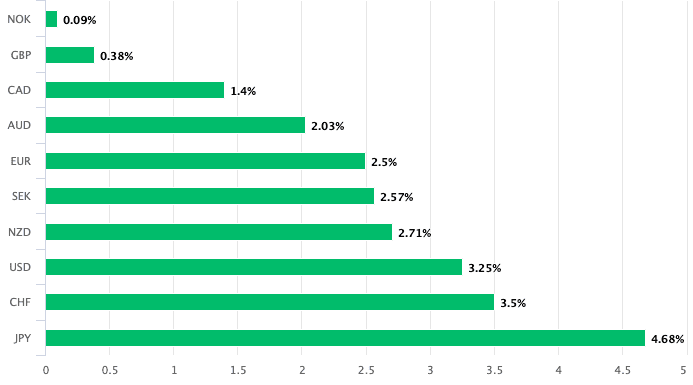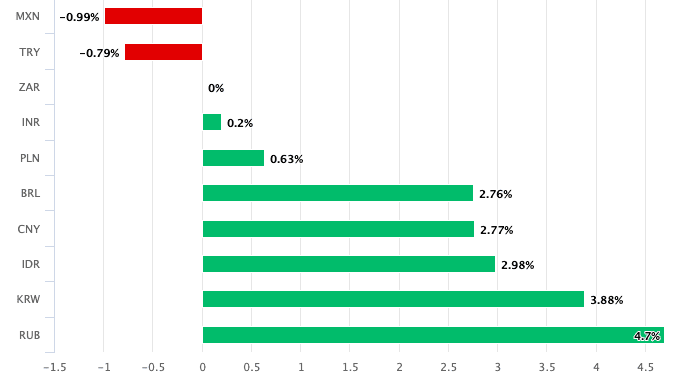South African Rand seeing Typical January Strength says Investec
- Written by: Gary Howes

Image © Adobe Stock
Strong seasonal factors are ensuring the South African Rand is one of the stars of early 2022 amidst strong demand for the country's assets by foreigners, according to a major South African merchant and investment bank.
Research from Investec finds the South African Rand tends to perform well in January "in its usual bout of seasonal strength".
However, looking further ahead ZAR "remains at risk of marked volatility, and weakness".
Annabel Bishop, Investec's Chief Economist, says foreigners have been active in South African markets this year so far and have snapped up R2.6BN worth of the country's bonds (net of sales), and R0.7BN net worth of equities in the middle of last week.
By contrast foreigners sold net R0.4BN worth of equities this year.
"Foreign inflows into South Africa’s portfolio assets this year so far stand at R2.2bn, which has bolstered the rand, and the favourable risk appetite is being driven by the usual increased seasonal risk taking of foreigners towards rand assets over the turn of the year," says Bishop.
The findings explain how the South African Rand is amongst the best performing global currencies of the year so far, only being surpassed by Mexico's Peso and the ultra-volatile Turkish Lira in the performance stakes:

Above: Rand performance against the G10.
"The northern hemisphere winter, December to February inclusive, typically sees increased investor interest in SA markets at this time, as most market players are at work compared to the thin market months in the northern hemisphere summer vacations," says Bishop.
"Heightened risk taking typically occurs over the northern hemisphere winter versus the low risk taking in the northern hemisphere summer. Rand assets are often in particular favour given the high liquidity and sophistication of the domestic financial markets," she adds.

Above: Rand performance against a selection of Emerging Market currencies and smaller developed market currencies.
Secure a retail exchange rate that is between 3-5% stronger than offered by leading banks, learn more.
As a result of these dynamics the Rand tends to strengthen in the first and last quarters of the year says Bishop.
Looking ahead, Bishop finds the currency tends to weaken in the middle two quarters of the year and this seasonality particularly comes to the fore when other drivers of the domestic currency are more subdued.
Concerning the all-important influence the U.S. Federal Reserve might have on the currency's outlook, Bishop says the recent FOMC minutes and meeting of 15th December 2021 provided the markets with significantly more certainty on the US monetary policy normalisation process, and consequently has reduced risk aversion for markets.
The minutes signalled the Fed could hike up to four times in 2022 while they could also begin the process of quantitative tightening; the process whereby the Fed stops renewing their holdings of bonds that expire, or they engage in outright sales of their bond holdings.
Stock markets fell on the back of the minutes in a 'risk off' reaction that suggests investors were concerned that the U.S. and global economies would suffer a setback as the cost of financing rose as a result of the Fed's decisions.
But, Investec's take is that the developments provide some much needed certainty, which markets typically like.
"With expected US rate hikes this year (the Fed fund futures are currently expecting up to three 25bp increases) and QE ending signalled as early as March, markets are relishing the increased certainty of the outlook, bolstering foreign investor portfolio flows into SA," says Bishop.
{wbamp-hide start}
{wbamp-hide end}{wbamp-show start}{wbamp-show end}
As such, "the rand consequently could strengthen through the R15.50/USD mark this month, potentially as early as this week, and moving towards R15.00/USD this quarter, if not stronger, although the domestic currency will also remain highly volatile."
Investec are forecasting the Dollar-Rand exchange rate at 15.50 by the end of the first quarter, 15.60 by the end of the second quarter, 15.85 by the end of the third quarter and 15.65 by year-end.
The Pound to Rand exchange rate is forecast at 21.23 by the end of the first quarter, 21.68 by the end of the second quarter, 22.58 by the end of the third quarter and 22.94 by year-end.
The Euro to Rand is forecast at 17.83, 17.94, 18.43 and 18.58 for the above timeframes.





